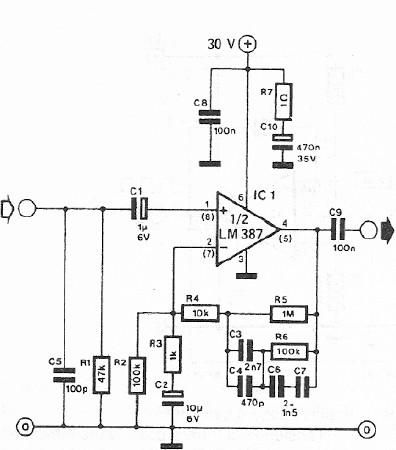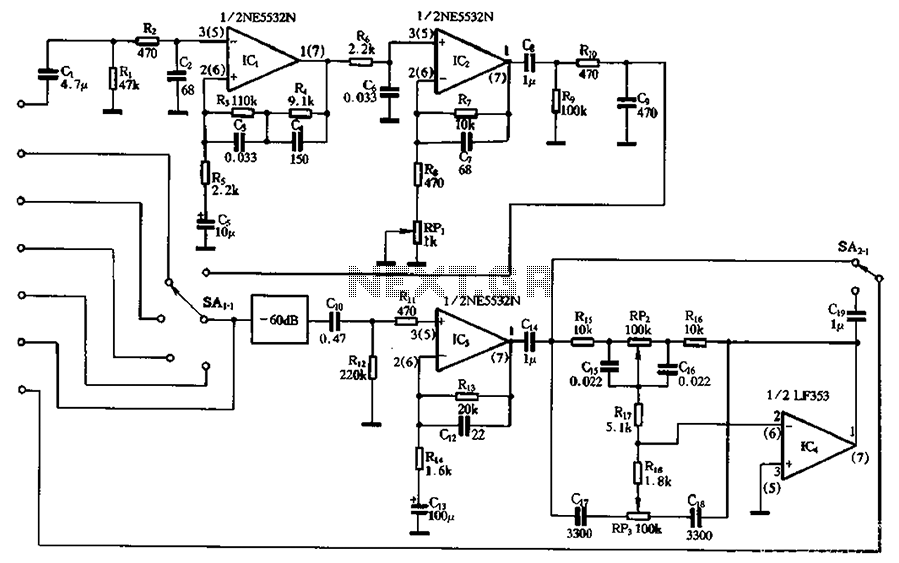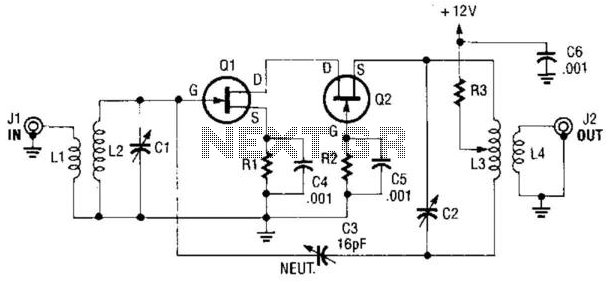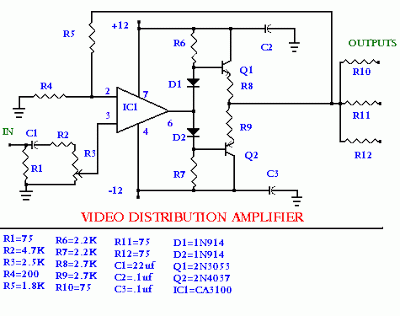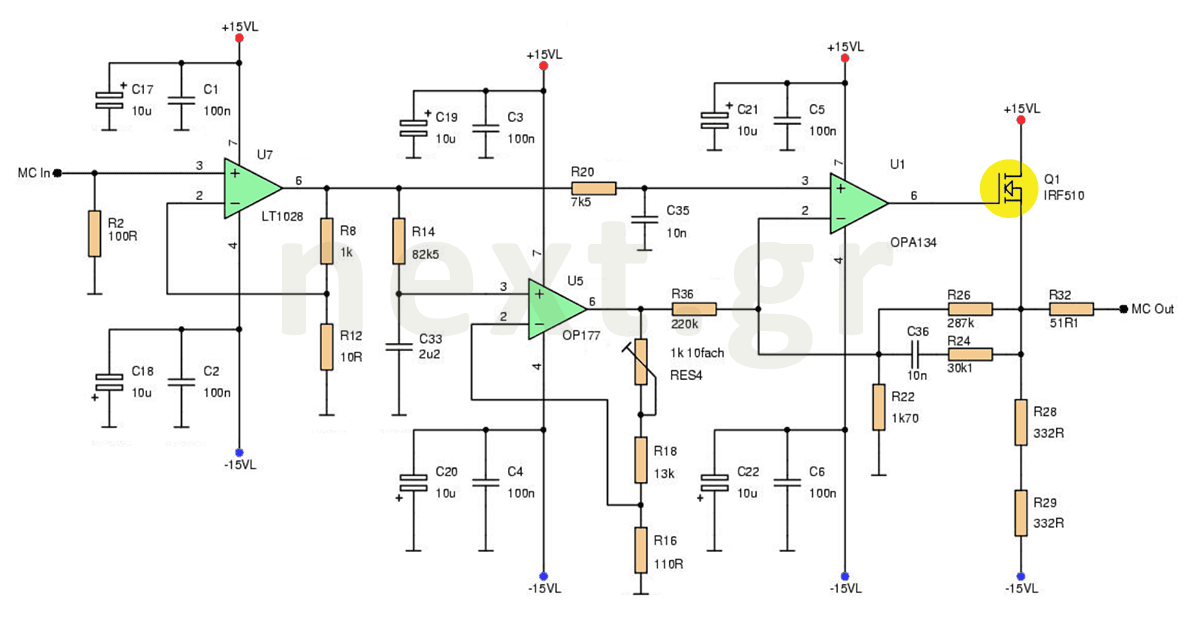
Class B audio amplifier
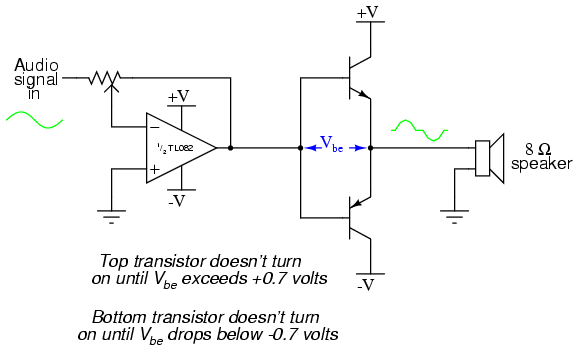
The closer the two transistors are matched, the better the performance. It is advisable to use TIP41 and TIP42 transistors, which are closely matched NPN and PNP power transistors with a dissipation rating of 65 watts each. If a TIP41 NPN transistor is unavailable, the TIP3055, which can be found at Radio Shack, serves as a suitable alternative. Avoid using very large power transistors (e.g., TO-3 case), as the operational amplifier may struggle to drive sufficient base current for optimal performance. This project involves an audio amplifier designed to amplify the output signal from small audio sources such as radios, tape players, or CD players. For stereo operation, two identical amplifiers need to be constructed, one for the left channel and another for the right channel. To obtain an input signal for amplification, connect it to the output of a radio or other audio device. This amplifier circuit is also effective at amplifying "line-level" audio signals from high-quality modular stereo components. It delivers a significant amount of sound power when played through a large speaker and can operate without heat sinks on the transistors, although experimentation is recommended before omitting heat sinks, as power dissipation varies with speaker type. The primary goal of any amplifier circuit is to reproduce the input waveform as accurately as possible. While perfect reproduction is unattainable, any discrepancies between the output and input waveforms are termed distortion. In audio amplifiers, distortion can introduce unwanted tones into the sound. Various audio amplifier circuit configurations exist, each with its own benefits and drawbacks. The circuit in question is a "class B" push-pull configuration, commonly used in audio power amplifiers. In this setup, one transistor supplies power to the load during one-half of the waveform cycle (the push phase), while a second transistor provides power during the other half (the pull phase). This arrangement allows each transistor to rest and cool during the waveform cycle, resulting in a power-efficient amplifier circuit. However, it also leads to a specific type of nonlinearity known as "crossover distortion." If the transition between the two transistors is not perfectly synchronized, the amplifier's output waveform may deviate from a pure sine wave. This distortion occurs due to the delay between the turn-off of one transistor and the turn-on of the other, causing the waveform to flatten at the crossover point between the positive and negative half-cycles. To reduce crossover distortion, a common technique is to bias the transistors so that their turn-on and turn-off points overlap, allowing both transistors to conduct briefly during the crossover period. This method is referred to as class AB amplification, as each transistor is "on" for more than 50% of the complete waveform cycle. However, this approach increases the amplifier's power consumption, as current flows through the transistors without contributing to the load during the overlap, leading to energy waste and increased heat dissipation. When transistors heat up, their characteristics change (e.g., Vbe forward voltage drop, junction resistances), complicating proper biasing. In this experiment, the transistors operate in pure class B mode, ensuring that they never conduct simultaneously, thus optimizing efficiency.
The audio amplifier circuit described is designed to deliver effective amplification for various audio sources while minimizing distortion and maximizing efficiency. The choice of closely matched transistors, specifically the TIP41 and TIP42, is crucial for achieving optimal performance, as their characteristics complement each other, resulting in improved linearity and reduced distortion. The circuit's class B configuration allows for efficient power usage, as each transistor only conducts during half of the waveform cycle. This design choice, while effective, necessitates careful attention to the synchronization of the transistors to avoid crossover distortion, which can degrade sound quality.
To implement this circuit, a power supply capable of providing the necessary voltage and current ratings for the TIP transistors is essential. The circuit should also include appropriate biasing resistors to set the operating point of the transistors, ensuring they operate within their optimal range. Additionally, capacitors may be used for coupling and decoupling purposes to maintain signal integrity and prevent unwanted feedback within the system.
When constructing the amplifier, attention must be paid to the layout and thermal management. Although the circuit can operate without heat sinks, it is advisable to monitor the temperature of the transistors under load conditions to prevent thermal runaway and ensure reliability. Proper grounding and shielding techniques should also be employed to minimize noise and interference, further enhancing the audio quality of the amplified output.
In summary, this audio amplifier circuit represents a practical solution for enhancing audio signals from various sources. By utilizing a class B push-pull configuration with matched transistors, it effectively balances power efficiency and sound quality, making it suitable for both casual listening and more demanding audio applications.The closer matched the two transistors are, the better. If possible, try to obtain TIP41 and TIP42 transistors, which are closely matched NPN and PNP power transistors with dissipation ratings of 65 watts each. If you cannot get a TIP41 NPN transistor, the TIP3055 (available from Radio Shack) is a good substitute.
Do not use very large (i. e. TO-3 case) power transistors, as the op-amp may have trouble driving enough current to their bases for good operation. This project is an audio amplifier suitable for amplifying the output signal from a small radio, tape player, CD player, or any other source of audio signals.
For stereo operation, two identical amplifiers must be built, one for the left channel and other for the right channel. To obtain an input signal for this amplifier to amplify, just connect it to the output of a radio or other audio device like this: This amplifier circuit also works well in amplifying "line-level" audio signals from high-quality, modular stereo components.
It provides a surprising amount of sound power when played through a large speaker, and may be run without heat sinks on the transistors (though you should experiment with it a bit before deciding to forego heat sinks, as the power dissipation varies according to the type of speaker used). The goal of any amplifier circuit is to reproduce the input waveshape as accurately as possible. Perfect reproduction is impossible, of course, and any differences between the output and input waveshapes is known as distortion.
In an audio amplifier, distortion may cause unpleasant tones to be superimposed on the true sound. There are many different configurations of audio amplifier circuitry, each with its own advantages and disadvantages. This particular circuit is called a "class B, " push-pull circuit. Most audio "power" amplifiers use a class B configuration, where one transistor provides power to the load during one-half of the waveform cycle (it pushes) and a second transistor provides power to the load for the other half of the cycle (it pulls).
In this scheme, neither transistor remains "on" for the entire cycle, giving each one a time to "rest" and cool during the waveform cycle. This makes for a power-efficient amplifier circuit, but leads to a distinct type of nonlinearity known as "crossover distortion.
" If the "hand-off" between the two transistors is not precisely synchronized, though, the amplifier`s output waveform may look something like this instead of a pure sine wave: Here, distortion results from the fact that there is a delay between the time one transistor turns off and the other transistor turns on. This type of distortion, where the waveform "flattens" at the crossover point between positive and negative half-cycles, is called crossover distortion.
One common method of mitigating crossover distortion is to bias the transistors so that their turn-on/turn-off points actually overlap, so that both transistors are in a state of conduction for a brief moment during the crossover period: This form of amplification is technically known as class AB rather than class B, because each transistor is "on" for more than 50% of the time during a complete waveform cycle. The disadvantage to doing this, though, is increased power consumption of the amplifier circuit, because during the moments of time where both transistors are conducting, there is current conducted through the transistors that is not going through the load, but is merely being "shorted" from one power supply rail to the other (from -V to +V).
Not only is this a waste of energy, but it dissipates more heat energy in the transistors. When transistors increase in temperature, their characteristics change (Vbe forward voltage drop, ², junction resistances, etc. ), making proper biasing difficult. In this experiment, the transistors operate in pure class B mode. That is, they are never conducting at the same time. This saves 🔗 External reference
The audio amplifier circuit described is designed to deliver effective amplification for various audio sources while minimizing distortion and maximizing efficiency. The choice of closely matched transistors, specifically the TIP41 and TIP42, is crucial for achieving optimal performance, as their characteristics complement each other, resulting in improved linearity and reduced distortion. The circuit's class B configuration allows for efficient power usage, as each transistor only conducts during half of the waveform cycle. This design choice, while effective, necessitates careful attention to the synchronization of the transistors to avoid crossover distortion, which can degrade sound quality.
To implement this circuit, a power supply capable of providing the necessary voltage and current ratings for the TIP transistors is essential. The circuit should also include appropriate biasing resistors to set the operating point of the transistors, ensuring they operate within their optimal range. Additionally, capacitors may be used for coupling and decoupling purposes to maintain signal integrity and prevent unwanted feedback within the system.
When constructing the amplifier, attention must be paid to the layout and thermal management. Although the circuit can operate without heat sinks, it is advisable to monitor the temperature of the transistors under load conditions to prevent thermal runaway and ensure reliability. Proper grounding and shielding techniques should also be employed to minimize noise and interference, further enhancing the audio quality of the amplified output.
In summary, this audio amplifier circuit represents a practical solution for enhancing audio signals from various sources. By utilizing a class B push-pull configuration with matched transistors, it effectively balances power efficiency and sound quality, making it suitable for both casual listening and more demanding audio applications.The closer matched the two transistors are, the better. If possible, try to obtain TIP41 and TIP42 transistors, which are closely matched NPN and PNP power transistors with dissipation ratings of 65 watts each. If you cannot get a TIP41 NPN transistor, the TIP3055 (available from Radio Shack) is a good substitute.
Do not use very large (i. e. TO-3 case) power transistors, as the op-amp may have trouble driving enough current to their bases for good operation. This project is an audio amplifier suitable for amplifying the output signal from a small radio, tape player, CD player, or any other source of audio signals.
For stereo operation, two identical amplifiers must be built, one for the left channel and other for the right channel. To obtain an input signal for this amplifier to amplify, just connect it to the output of a radio or other audio device like this: This amplifier circuit also works well in amplifying "line-level" audio signals from high-quality, modular stereo components.
It provides a surprising amount of sound power when played through a large speaker, and may be run without heat sinks on the transistors (though you should experiment with it a bit before deciding to forego heat sinks, as the power dissipation varies according to the type of speaker used). The goal of any amplifier circuit is to reproduce the input waveshape as accurately as possible. Perfect reproduction is impossible, of course, and any differences between the output and input waveshapes is known as distortion.
In an audio amplifier, distortion may cause unpleasant tones to be superimposed on the true sound. There are many different configurations of audio amplifier circuitry, each with its own advantages and disadvantages. This particular circuit is called a "class B, " push-pull circuit. Most audio "power" amplifiers use a class B configuration, where one transistor provides power to the load during one-half of the waveform cycle (it pushes) and a second transistor provides power to the load for the other half of the cycle (it pulls).
In this scheme, neither transistor remains "on" for the entire cycle, giving each one a time to "rest" and cool during the waveform cycle. This makes for a power-efficient amplifier circuit, but leads to a distinct type of nonlinearity known as "crossover distortion.
" If the "hand-off" between the two transistors is not precisely synchronized, though, the amplifier`s output waveform may look something like this instead of a pure sine wave: Here, distortion results from the fact that there is a delay between the time one transistor turns off and the other transistor turns on. This type of distortion, where the waveform "flattens" at the crossover point between positive and negative half-cycles, is called crossover distortion.
One common method of mitigating crossover distortion is to bias the transistors so that their turn-on/turn-off points actually overlap, so that both transistors are in a state of conduction for a brief moment during the crossover period: This form of amplification is technically known as class AB rather than class B, because each transistor is "on" for more than 50% of the time during a complete waveform cycle. The disadvantage to doing this, though, is increased power consumption of the amplifier circuit, because during the moments of time where both transistors are conducting, there is current conducted through the transistors that is not going through the load, but is merely being "shorted" from one power supply rail to the other (from -V to +V).
Not only is this a waste of energy, but it dissipates more heat energy in the transistors. When transistors increase in temperature, their characteristics change (Vbe forward voltage drop, ², junction resistances, etc. ), making proper biasing difficult. In this experiment, the transistors operate in pure class B mode. That is, they are never conducting at the same time. This saves 🔗 External reference
